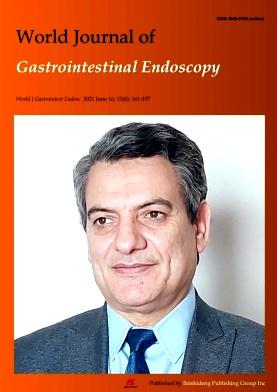Evaluation of appendiceal mucinous neoplasms by curved linear-array echoendoscope: A preliminary study
IF 1.4
Q4 GASTROENTEROLOGY & HEPATOLOGY
引用次数: 0
Abstract
BACKGROUND Preoperative diagnosis of appendiceal mucinous neoplasms is challenging, and there are few reports regarding the endosonographic characteristics of these neoplasms. AIM To provide a retrospective assessment of the imaging features of appendiceal mucinous neoplasms using endoscopic ultrasound (EUS) by curved linear-array echoendoscope. METHODS A database of all patients with appendiceal mucinous neoplasms who had received EUS examination at our hospital between January 2018 and July 2023 was retrospectively analyzed. The EUS characteristics and patients’ clinical data were reviewed. RESULTS Twenty-two patients were included in the study. The linear-array echoendoscope successfully reached the ileocecal region in every patient. In the endoscopic view, we could observe the protrusion in the appendiceal orifice in all patients. A volcano sign was observed in two patients, and an atypical volcano sign was seen in two patients. EUS showed that all 22 lesions were submucosal cystic hypoechoic lesions with clear boundaries. No wall nodules were observed, but an onion-peeling sign was observed in 17 cases. CONCLUSION Linear-array echoendoscope is safe to reach the ileocecal region under the guidance of EUS. Image features on endoscopic and echoendosonograhic views could be used to diagnose appendiceal mucinous neoplasms.用弧形线性阵列回声内窥镜评估阑尾粘液瘤:初步研究
背景 阑尾粘液性肿瘤的术前诊断具有挑战性,有关这些肿瘤的内镜特征的报道很少。目的 使用曲面线性阵列回声内窥镜进行内窥镜超声检查(EUS),对阑尾粘液性肿瘤的成像特征进行回顾性评估。方法 对2018年1月至2023年7月期间在我院接受过EUS检查的所有阑尾粘液性肿瘤患者的数据库进行回顾性分析。回顾性分析了 EUS 特征和患者的临床数据。结果 研究共纳入 22 例患者。直线阵列回声内镜成功到达每位患者的回盲部。在内窥镜视野中,我们可以观察到所有患者的阑尾孔突出。两名患者出现火山征,两名患者出现非典型火山征。EUS 显示,所有 22 个病灶均为粘膜下囊性低回声病灶,边界清晰。未观察到壁结节,但在 17 例病例中观察到洋葱剥离征。结论 线性阵列回声内镜可在 EUS 引导下安全到达回盲部。内镜和回声内镜视图上的图像特征可用于诊断阑尾粘液性肿瘤。
本文章由计算机程序翻译,如有差异,请以英文原文为准。
求助全文
约1分钟内获得全文
求助全文

 求助内容:
求助内容: 应助结果提醒方式:
应助结果提醒方式:


